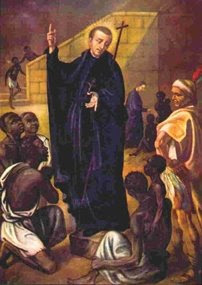San Pedro Claver (Saint Peter Claver)
 When we think about Civil Rights and Anti-Slavery movements from a 2oth century perspective, we think of the bravery of the early Civil Rights leaders. We talk about Martin Luther King, Bishop Tutu, and others. The men and women of Civil Rights movements have always bucked the current. However, it is one thing to do that in the 20th or 21st Century. It was quite another thing to do so in the 1600's.
When we think about Civil Rights and Anti-Slavery movements from a 2oth century perspective, we think of the bravery of the early Civil Rights leaders. We talk about Martin Luther King, Bishop Tutu, and others. The men and women of Civil Rights movements have always bucked the current. However, it is one thing to do that in the 20th or 21st Century. It was quite another thing to do so in the 1600's.This is what leads us to the story of the San Pedro Claver (Saint Peter Claver), the man known as a "slave to the slaves.". Whether or not you are Catholic, whether or not you are Afrocolombian, everyone can appreciate the life and dedication of this great, caring, progressive man.
San Pedro Claver was born in Verd, Spain, on June 26, 1580. He became a Jesuit in 1602 and sailed to what is today Colombia in 1610. He became the Priest of Cartagena de Indias on March 16, 1616. Eight years later, he made a commitment that would change his life. On April 3, 1622, he wrote a commitment to God that he signed in the following way: "Petrus Claver, aethiopum semer servus." "Pedro Claver esclavo de los esclavos negros para siempre," or "Peter Claver slave of the black slaves forever." After making this commitment, he spent the next 32 years working to help protect and defend the newly arrived African slaves in Cartagena.
During the 1600's, over 1 million African slaves were shipped to Caratgena. Below, you can read what Pedro Claver wrote about their arrival in Cartagena from his own experience:
"The ship has gone through the Fort of Pastelillo and port movement can be heard. Inside the galleon there is a murmur. Screams of fright, anxious looks. The slaves traders show their softest faces. Only one third of the merchandise has arrived: there is an interest of giving a good impression, 'Smile slaves, smile!' When these Negroes are enslaved, they are put in dirty prisons from where they only come out at the port of Cartagena. Sometimes in one year, 12 to 14 ships come to Cartagena with the repulsive shipment of sad and melancholic Negroes. They have the idea that once in Cartagena they will be killed. One third of the shipment usually dies during the long journey. The slave traders bring these slaves in bunches of six, necks and feet chained. They make the trip in the bottom of the ship where they never can see the sunlight, the place is so dirty that anyone could get sick with only getting in. They are fed every 24 hours, half a plate of corn meal or raw "mijo" and a small cup of water. They received bad words and chastisements. Because of this treatment, the slaves are like skeletons when they arrive. Then they are brought to, and kept in, a corral, or large patio, where many people go to see them, some only out of curiosity, others guided by their covetousness, and still there are some who come out for compassion: in this last group are the missionaries, they usually go running when the shipment arrives, but very often they find many dead".
In his work, Pedro Claver would enter into the dark, damp, putrid holds of the slave ships that arrived in the harbor. Typically, over 1/3 of the slave cargo would have died en route, and those that had survived the journey, typically would be suffering from some kind of aliment. Upon entering the ship, Father Claver would try to calm the fears of the desperate Africans, most of whom were certain that they would be killed at any moment. Unable to speak to them in their native languages, Father Claver would embrace them, kiss their wounds, and use interpreters to explain that he was there to help them. In addition to his healing work among the newly arrived slaves, he evangelized and baptized many Negroes.

Comments
http://penguin.lazuras.org/main.php?g2_itemId=2449
Daughter is from Cartagena! :o) I had never heard of the book....Thanks!